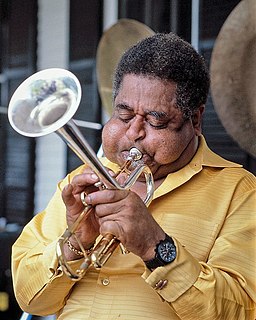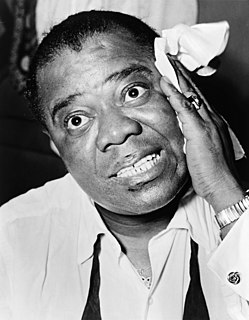Related Research Articles

Bebop or bop is a style of jazz developed in the early-to-mid-1940s in the United States. The style features compositions characterized by a fast tempo, complex chord progressions with rapid chord changes and numerous changes of key, instrumental virtuosity, and improvisation based on a combination of harmonic structure, the use of scales and occasional references to the melody.

John Birks "Dizzy" Gillespie was an American jazz trumpeter, bandleader, composer, educator and singer. He was a trumpet virtuoso and improviser, building on the virtuoso style of Roy Eldridge but adding layers of harmonic and rhythmic complexity previously unheard in jazz. His combination of musicianship, showmanship, and wit made him a leading popularizer of the new music called bebop. His beret and horn-rimmed spectacles, scat singing, bent horn, pouched cheeks, and light-hearted personality provided one of bebop's most prominent symbols.

Maxwell Lemuel Roach was an American jazz drummer and composer. A pioneer of bebop, he worked in many other styles of music, and is generally considered one of the most important drummers in history. He worked with many famous jazz musicians, including Coleman Hawkins, Dizzy Gillespie, Charlie Parker, Miles Davis, Duke Ellington, Thelonious Monk, Abbey Lincoln, Dinah Washington, Charles Mingus, Billy Eckstine, Stan Getz, Sonny Rollins, Eric Dolphy, and Booker Little. He was inducted into the DownBeat Hall of Fame in 1980 and the Modern Drummer Hall of Fame in 1992.

Earl Rudolph "Bud" Powell was an American jazz pianist and composer. Along with Charlie Parker, Thelonious Monk, and Dizzy Gillespie, Powell was a leading figure in the development of modern jazz. His virtuosity led many to call him the Charlie Parker of the piano. Powell was also a composer, and many jazz critics credit his works and his playing as having "greatly extended the range of jazz harmony".
Carlos Wesley "Don" Byas was an American jazz tenor saxophonist, associated with Swing and bebop. He played with Count Basie, Duke Ellington, Art Blakey, and Dizzy Gillespie, among others, and also led his own band. He lived in Europe for the last 26 years of his life.

Coleman Randolph Hawkins, nicknamed "Hawk" and sometimes "Bean", was an American jazz tenor saxophonist. One of the first prominent jazz musicians on his instrument, as Joachim E. Berendt explained: "there were some tenor players before him, but the instrument was not an acknowledged jazz horn". Hawkins biographer John Chilton described the prevalent styles of tenor saxophone solos prior to Hawkins as "mooing" and "rubbery belches." Hawkins cited as influences Happy Caldwell, Stump Evans, and Prince Robinson, although he was the first to tailor his method of improvisation to the saxophone rather than imitate the techniques of the clarinet. Hawkins' virtuosic, arpeggiated approach to improvisation, with his characteristic rich, emotional, and vibrato-laden tonal style, was the main influence on a generation of tenor players that included Chu Berry, Charlie Barnet, Tex Beneke, Ben Webster, Vido Musso, Herschel Evans, Buddy Tate, and Don Byas, and through them the later tenormen, Arnett Cobb, Illinois Jacquet, Flip Phillips, Ike Quebec, Al Sears, Paul Gonsalves, and Lucky Thompson. While Hawkins became known with swing music during the big band era, he had a role in the development of bebop in the 1940s.

Oscar Pettiford was an American jazz double bassist, cellist and composer. He was one of the earliest musicians to work in the bebop idiom.

Theodore "Fats" Navarro was an American jazz trumpet player. He was a pioneer of the bebop style of jazz improvisation in the 1940s. He had a strong stylistic influence on many other players, including Clifford Brown.

Eli "Lucky" Thompson was an American jazz tenor and soprano saxophonist whose playing combined elements of swing and bebop. Although John Coltrane usually receives the most credit for bringing the soprano saxophone out of obsolescence in the early 1960s, Thompson embraced the instrument earlier than Coltrane.

Minton's Playhouse is a jazz club and bar located on the first floor of the Cecil Hotel at 210 West 118th Street in Harlem, Manhattan, New York City. It is a registered trademark of Housing and Services, Inc. a New York City nonprofit provider of supportive housing. The door to the actual club itself is at 206 West 118th Street where there is a small plaque. Minton's was founded by tenor saxophonist Henry Minton in 1938. Minton's is known for its role in the development of modern jazz, also known as bebop, where in its jam sessions in the early 1940s, Thelonious Monk, Bud Powell, Kenny Clarke, Charlie Christian, Charlie Parker and Dizzy Gillespie pioneered the new music. Minton's thrived for three decades until its decline near the end of the 1960s, and its eventual closure in 1974. After being shuttered for more than 30 years, the newly remodeled club reopened its doors on May 19, 2006, under the name Uptown Lounge at Minton's Playhouse. However, the reopened club was closed again in 2010. Remodeling began again in 2012.
Dillon "Curley" Russell was an American jazz musician, who played bass on many bebop recordings.
"Salt Peanuts" is a bebop tune reportedly composed by Dizzy Gillespie in 1942, credited "with the collaboration of" drummer Kenny Clarke. It is also cited as Charlie Parker's. The original lyrics have no exophoric meaning. Instead, they are a skat/bebop vocal which matches the octave note interval played predominantly throughout the song. The Pointer Sisters subsequently included vocalese lyrics for their rendition of Salt Peanuts as recorded on their That's a Plenty album.

Mary Osborne was an American jazz guitarist and guitar manufacturer. She began performing at a young age and was featured on a radio program in North Dakota, where she grew up. In New York City during the 1940s, she played with jazz musicians such as Dizzy Gillespie, Art Tatum, Coleman Hawkins, and Thelonious Monk. After moving to California in 1968, she and her husband founded the Osborne Guitar Company.
Nelson Boyd was an American bebop jazz bassist.
"Little" Benny Harris was an American bebop trumpeter and composer.

In the early 1940s in jazz, bebop emerged, led by Charlie Parker, Dizzy Gillespie, Thelonious Monk and others. It helped to shift jazz from danceable popular music towards a more challenging "musician's music." Differing greatly from swing, early bebop divorced itself from dance music, establishing itself more as an art form but lessening its potential popular and commercial value. Since bebop was meant to be listened to, not danced to, it used faster tempos. Beboppers introduced new forms of chromaticism and dissonance into jazz; the dissonant tritone interval became the "most important interval of bebop" and players engaged in a more abstracted form of chord-based improvisation which used "passing" chords, substitute chords, and altered chords. The style of drumming shifted as well to a more elusive and explosive style, in which the ride cymbal was used to keep time, while the snare and bass drum were used for accents. This appealed to a more specialized audiences than earlier forms of jazz, with sophisticated harmonies, fast tempos and often virtuoso musicianship. Bebop musicians often used 1930s standards, especially those from Broadway musicals, as part of their repertoire. Among standards written by bebop musicians are Gillespie's "Salt Peanuts" (1941) and "A Night in Tunisia" (1942), Parker's "Anthropology" (1946), "Yardbird Suite" (1946) and "Scrapple from the Apple" (1947), and Monk's "'Round Midnight" (1944), which is currently the most recorded jazz standard composed by a jazz musician. An early 1940s style known as "jumping the blues" or jump blues used small combos, uptempo music, and blues chord progressions. Jump blues drew on boogie-woogie from the 1930s. Kansas City Jazz in the 1930s as exemplified by tenor saxophonist Lester Young marked the transition from big bands to the bebop influence of the 1940s. These divergences from the jazz mainstream of the time initially met with a divided, sometimes hostile response among fans and fellow musicians, especially established swing players, who bristled at the new harmonic sounds. To hostile critics, bebop seemed to be filled with "racing, nervous phrases". Despite the initial friction, by the 1950s bebop had become an accepted part of the jazz vocabulary. The most influential bebop musicians included saxophonist Charlie Parker, pianists Bud Powell and Thelonious Monk, trumpeters Dizzy Gillespie and Clifford Brown, and drummer Max Roach.
Kermit "Scotty" Scott was a jazz tenor saxophonist. Dizzy Gillespie considered Scott “one of the founders of our music” [bop].
Joseph Luke Guy was an American jazz trumpeter. Guy had a promising career as a young progressive bop musician as he worked alongside more prominent musical acts until a drug addiction sidelined him from further success.

Rainbow Mist is an album by the American jazz saxophonist Coleman Hawkins compiling recordings from 1944 originally released by Apollo Records that was released by the Delmark label in 1992.
References
- 1 2 Gottlieb, Bill (24 September 1947). "Thelonious Monk -- Genius Of Bop". Down Beat. Retrieved 7 June 2013.
- 1 2 3 DeVeaux, Scott (1999). The Birth of Bebop: A Social and Musical History. University of California Press. p. 233. ISBN 978-0520216655.
- ↑ Feather, Leonard. "Somethin' Else". The Cannonball Adderley Rendez-vous. Retrieved 7 June 2013.
- ↑ Gillespie, Dizzy and Al Fraser (2009). To Be, or Not . . . to Bop. Univ Of Minnesota Press. ISBN 978-0816665471.
- 1 2 Martin, Henry; Keith Waters (2008). Essential Jazz: The First 100 Years (2 ed.). Cengage Learning. ISBN 978-0495505259.